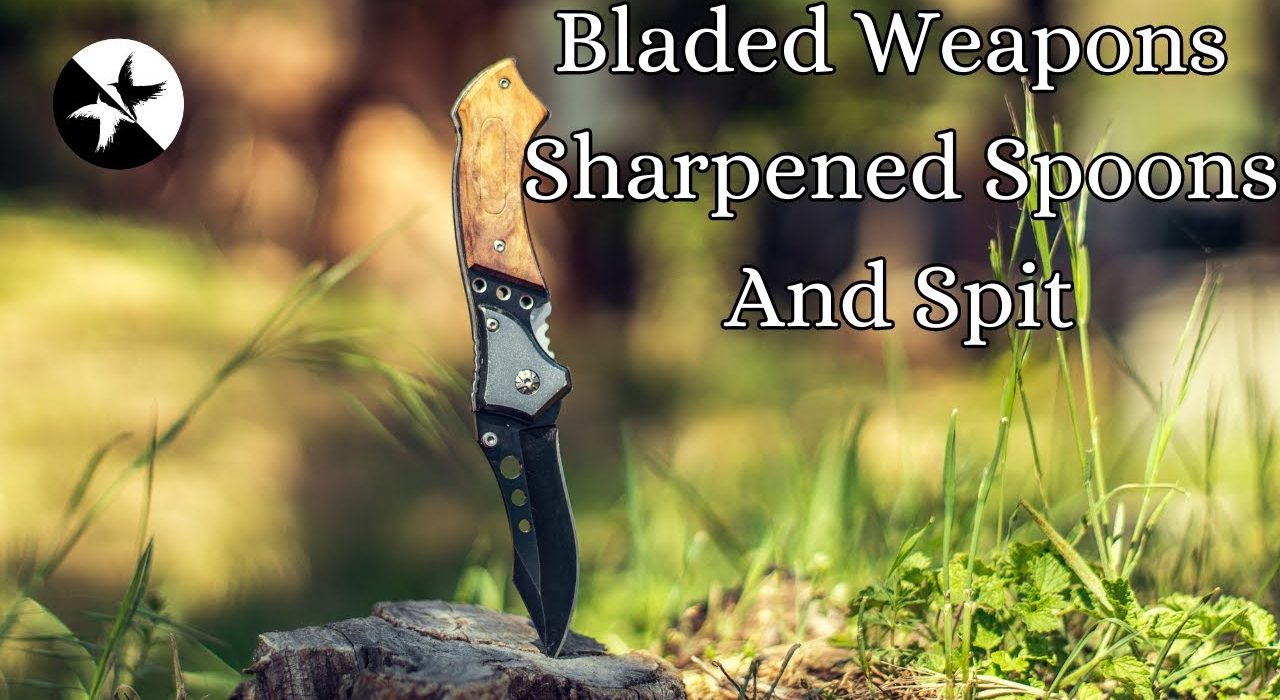What is the best angle to sharpen a straight razor? What do diamonds have to do with sharpening knives? Who was spitting? Why were the spoons sharpened? Find out on this episode.
Welcome to Writing Rural with Alley, the fiction writer’s inspiration station for rural life and lifestyles, from historical to post-apocalyptic, helping you bring your rural stories to life! I’m Alley, and this is my one-year anniversary week of the launch of this podcast. Thank you to all my listeners. You guys are awesome! For this special episode, I have one near and dear to my heart, so without further ado, I give you episode 58, Knife Sharpening. Stick around to the end to find out all the ways things could go wrong. Now, let’s get into this.
Knives have been around since sometime around 3000 BC. They were originally made of copper and bronze, and used for everything from hunting to war to domestic chores like cooking, and in the process of making clothing. All of these things wear the knife edge down and dull it. Your character will need to be able to sharpen their knife.
Yes, I know there were stone knives before 3000 BC, but I’m specifically talking about ones that can be sharpened. Knives have been an important tool ever since.
Let’s start with what a knife will be sharpened with. A sharpening stone. I know; it’s a super creative name. cough, cough. Not! cough, cough There are four types of sharpening stones: water stone, oil stone, diamond stone, and Arkansas stone. The Arkansas stone is sometimes called the Novaculite stone. These stones today are usually a rectangular shape.
The oil stone is a man-made stone that has ingredients coarse enough to grind away metal and is held together with a bonding ingredient. I only find two types: Silicon Carbide and Aluminum Oxide. These stones are called oil stones because they are lubricated with oil to glide the knife across effectively as it is sharpened.
Next is the water stone. Yes, water stones get their name because they are lubricated with water. These were originally natural stones. There are two main ones: the Belgium Whetstone and the Japanese Whetstone. There is also a synthetic water stone. This type will often wear faster than other stones and will have to be smoothed out as the part of the stone that is used most often will wear down. The smoothing-out process is sometimes called lapping.
The Arkansas Stone is a natural stone originating in… can you guess it? Arkansas! They are sometimes called Novaculite, which is Latin for razor stone. These can be water or oil stones. They were first used by Native Americans and used for trading. In the 1800s, the settlers there started mining them for sale and have since become popular internationally.
Last is the Diamond Stone. These are man-made diamonds electroplated into stones. These will sharpen anything with a cutting edge, including ceramic knives, which is why they are popular, especially in the kitchen, both at home and professionally.
Each type of stone will be cared for in a different way. Let me know if you’d like an episode on how to care for the sharpening stones.
Each stone will have its own grit from the Extremely Course at under 150 grit that helps grind the knife edge down to work out nicks in the blade up to Mirror Polish at 10,000+ grit. This will leave a razor-sharp edge with a reflective finish that shows no signs of imperfections.
Basically, sharpening is happening by the grinding away of some of the metal at an angle that meets with the other side to make it “sharp.” The lower the grit, the faster the metal comes off, but low grit numbers can make them look scratched. However, high end grit leaves no marks or even leaves a mirror finish. These can be sharper than modern machinery sharpened razors. I dare say that about 99% of the world does not make their knives this sharp.
For regular knives that are used for day-to-day work, 700 to 2,000 is the average grit. Axes, tomahawks, butter knives, and other duller blades will use roughly 400 grit stones. If a person uses a stone over 2,000 grit, it is likely they are sharpening a straight razor. Keep in mind many of these are sharpened in stages, increasing increments of grit to get them to the ideal sharpness. There can also be curved stones. These sharpen things like scythes and sickles, chainsaw blades, curved kitchen knives, and more.
Next, we need to get into the how-tos. The first concept is the angle that will be used. Angles below 10 degrees are very easy to damage or break. Put simply, it will not hold up to cutting paper. The only thing I know that has an angle of ten degrees or under is a straight razor. Ten to sixteen degree angles are still very prone to being too weak to hold up to most things. Basically, you can’t chop food with them. Seventeen to about twenty-five is the typical angle of most professional kitchen knives. These are a bit more durable, but as with all knives will need sharpened with use. Twenty-six to thirty degrees is what most knives will be sharpened to. Also, knives that will see more abuse and cutting through thicker or harder materials will use this. The most widely known being pocket knives and whittling knives. Also, hunting knives will normally fall into this. Anything over thirty to forty is a useable edge, but not made for cutting. This includes axes, hatchets, butter knives, and things of that nature.
The next thing you need to know is what the bevel of a knife is because that is
the part your character will be sharpening. The edge of the knife from where it starts to sloop down to the cutting edge is called the bevel. It is the part of the knife with the angle. Most knives have double-edged blades, meaning both sides of the cutting edge are angled, but some knives only have one side of the knife angled. Or if you want to get technical, there are single-beveled and double-beveled knives. The most well known single-bladed knife is a single-edged straight razor. I do not mean the disposable kind. Not all straight razors are single-edged, but the vast majority of them are.
Most modern people will have a flat rectangular-shaped sharpening stone, so let’s cover it first. The stone will be placed on a flat surface. The knife will then be placed at the preferred angle to be pushed or pulled across the knife edge, from handle to tip.
While you should always start at the handle and sharpen to the tip, there is a debate about whether you should push the edge, as in sharpening from the tip of the bevel to the wider knife, or if you should pull it, as in from the knife down the bevel to the tip.
Let me be clear here that when done right, both ways will sharpen a knife. I know, I can hear hunters screaming at me already, but hear me out. Knife sharpening done in a professional kitchen is done with the edge pushed along the sharpening stick. Sorry if that is the wrong term, but it’s all I got. However, most modern bush crafters will pull the knife ending on the edge. Either way, the knife will be done from handle to tip ten times on each side of the bevel, unless it is single sided, then it is done on only one side. After ten, it is flipped back to the other side. This is to keep blade wear consistent.
So, what are my personal thoughts about all this? I’m of the option that I don’t care what way it goes. Keeping a consistent angle all the way to the tip is the most important thing, and anything past that is preferences. Many people
struggle with the tip of the knife, because they have a different angle as they turn the upsweep of the blade. Keeping the same angle matters.
This is done until they believe the blade is sharp enough. Then it must be tested. Many people use paper to test the sharpness. If it goes through like butter, it is good. Many people in history and to this day will do a hair test. Yes, they might do the hair-splitting test to see if they can cut a hair long way in half. However more often, they test it like they would a razor. Some people use a small spot on their leg, others their arm. I’ve known people that would see if it could peel an ultra thin layer of fingernail.
Now for some fun parts! I got to practice my knife sharpening skills at an old army surplus store with a lot of army vets, so I have some tips and tricks. First, most people sharpen across the shorter section of a sharpening stone, but it is easier to hold the same edge if you sharpen long ways. This is especially true for longer knives.
Next, lock your wrist, and find a single way to hold your knife, whatever works for you, and do not deviate from it. This will help make sure that your angle is always the same.
If you want a sharp tip, you need to sharpen to the tip. For some reason, a lot of people do not finish the last few centimeters of the blade, and I do not understand why. Do this with every single sharpening stroke, and you do not need to worry about redoing the tip later.
Next, your character might not have oil or water on hand for lubricating oil and water stones. I’ll be honest, I saw the guys spit on the stones and use that so much that I was older before I learned that spit was not how water stones were lubricated. For the oil stones, I have seen them use cooking oils and even zippo lighter fluid. I am not saying lighter fluid is a good idea, but I have seen it done.
The point to all of this is that, when the proper thing is not available, your character might have to improvise or let their kid spit on the sharpening stone.
Knife sharpening is a learned skill. It is not too hard to learn but does take practice. The more practice, the easier it is. I have been doing this since I was a kid and can do it without really thinking about it as I do and can have a knife done in five or less minutes. However, that is a lifetime of practice, and I know people, my husband included, that are a lot better at it than me.
Fun story, my dad once sharpened the spoons for some company he didn’t like. Let’s say people are a bit worried when they eat from a set of sharpened utensils.
Like all things, when a person learns this, it really depends on circumstances. All our kids got knives around seven and started learning to take care of them and sharpen them then. In the Amish communities, it is a much younger age than that. However, some kids need to wait until they are older. If you are writing apocalypse, it will likely be a learner curve for most people, and they are going to appreciate that old kook they made fun of for stuff like that.
Fun fact: The two most famous knives in history are the Bowie knife that came out in 1830 and the Swiss Army Knife that came out in 1891.
What could possibly go wrong?
Before we get to the best part, if you enjoy this podcast, I hope you’ll take a minute to follow, rate, and review on your podcasting platform. And if you are listening on YouTube, subscribe and hit that like button. Don’t forget to share with a friend. Now for everyone’s favorite part!
Likely to go wrong: Your character is trying to sharpen their knife with one hand and hold the sharpening stone with the other. They slip and cut their finger open.
Likely to go wrong: Your character is learning to sharpen a knife, and they change the angle of the knife in the centimeter or so leading up to the tip of the knife. This makes the knife uneven, and the tip might not be as sharp as the rest of the knife.
Likely to go wrong: Your character is trying to learn how to sharpen a knife alone during the apocalypse and doesn’t know how the angles work or what way to move the knife to sharpen it. They accidentally dull the knife instead of sharpen it.
Possible to go wrong: Your character uses a larger angle to sharpen a straight razor. This could cause razor burn as the razor is not as sharp as it should be.
Possible to go wrong: Your character always sharpens knives on the same place on their stone, and after a lot of use, the stone wears down in only the spot they used so much.
Possible to go wrong: Your character thinks that using a low angle to sharpen a knife will make it sharper. However, they soon find that all they did was make the cutting edge weaker and easier to bend or nick.
Unlikely to go wrong: Your character did not know there were two sides of a knife blade and only sharpened one side. This could cause the edge to be weak and it breaks or warps easily.
Unlikely to go wrong: Your character grew up seeing people spit on wet stones as lubrication and believes that is the way to care for wet stones.
Unlikely to go wrong: Your character didn’t know that their straight razor was a single-edge bevel. They try to sharpen the other side and, in doing so, dull the blade.
Improbable but still technically in the realm of possibilities: Your character places a sharpening stone on their leg as they sharpen the knife. Your character uses more force than needed to sharpen a knife causing them to slip and stab their leg. If they hit the artery in their leg, this could be deadly.
Improbable but still technically in the realm of possibilities: Your character uses lighter fluid to lubricate an oil stone while sharpening a carbon steel knife. The grinding of the blade with sharpening makes a spark and lights the lighter fluid, and everything is on fire. This could include the sharpening stone, knife, or even your character’s fingers.
Thanks for listening! You can find the show notes and helpful links to learn more on my website, alleyhart.com. That’s A-L-L-E-Y-H-A-R-T.com. Subscribe or follow for more episodes. Connect by dropping me a comment on my YouTube videos. A new episode comes out every Monday. Until then. Happy wordsmithing.
Helpful links to learn more:
History of sharpening stones:
Sharpening stone types:
https://www.nortonabrasives.com/en-us/resources/expertise/choosing-sharpening-stone
https://encyclopediaofarkansas.net/entries/novaculite-2220/
Grit of stone chart:
https://www.sharpeningsupplies.com/Sharpening-Stone-Grit-Chart-W21.aspx
How to sharpen a knife:
https://www.marthastewart.com/8368238/how-to-sharpen-a-knife
https://us.santokuknives.co.uk/blogs/blog/should-you-push-or-pull-when-sharpening-a-knife
Sharpening angle:
https://www.sharpeningsupplies.com/Detailed-Discussion-on-Knife-Sharpening-Angles-W28.aspx



